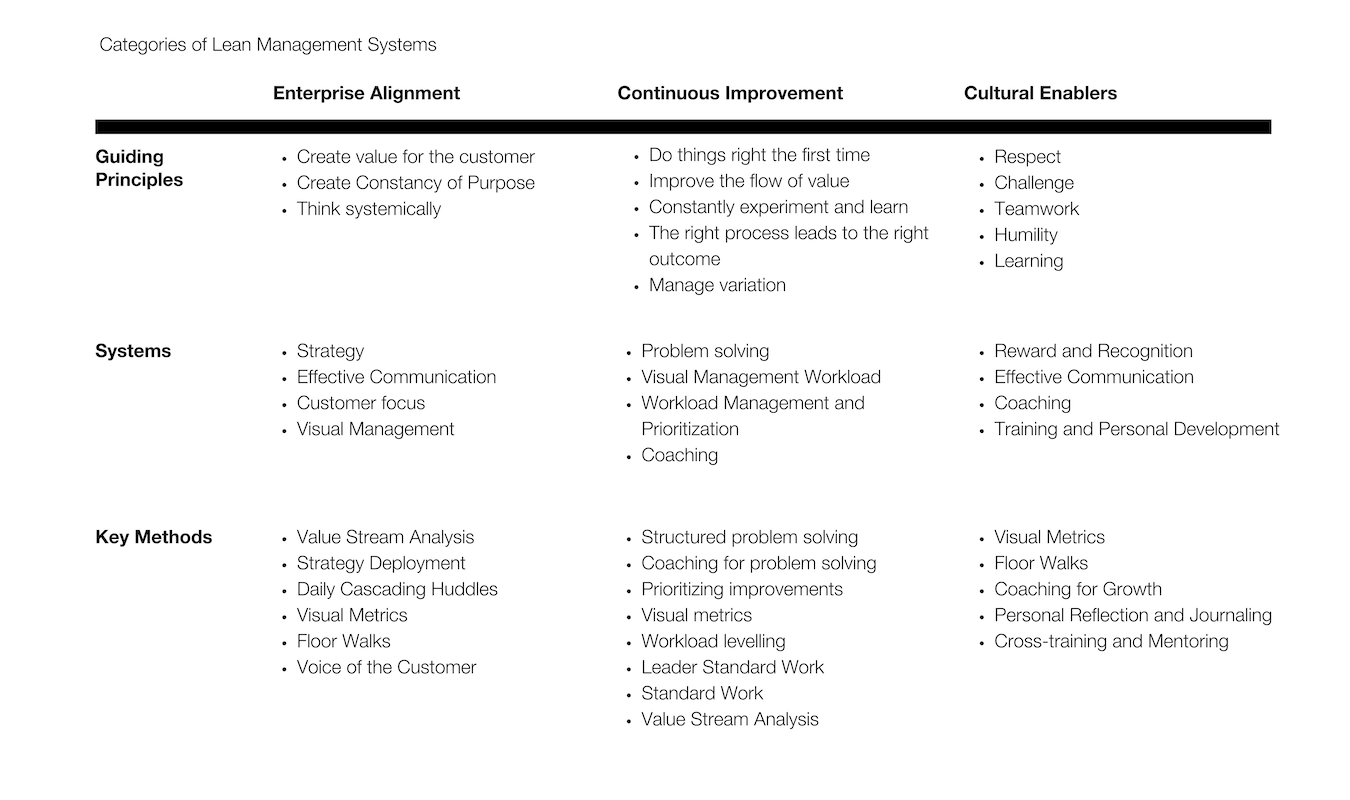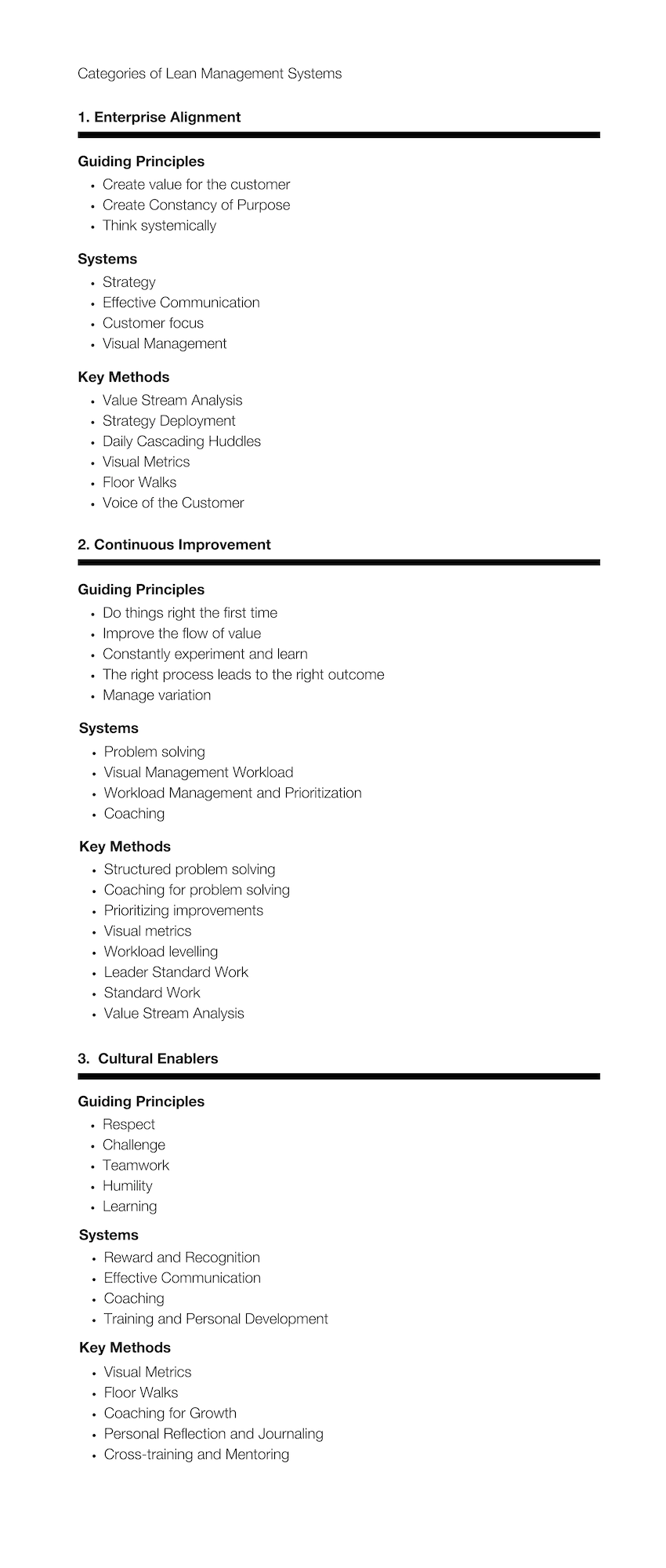Tried implementing Lean only to find that the benefits of the project evaporated within a couple years? This is not unusual. Sustaining Lean improvements is a challenge for many organizations because they lack the necessary Lean Management Systems.
A Lean Management System is not something you download onto your phone, but a behavioural routine that Lean leaders, or those aspiring to become Lean leaders, adopt to create, develop and sustain a Lean culture throughout their organization.
A system is just a set of interrelated parts that act together towards a common purpose. A Lean Management system brings together a variety of Lean tools and leadership behaviours (the parts) to build a Lean culture (the system) of sustainable and long-term improvement
While there many Lean Management Systems, they can be organized into three broad categories: those that serve primarily to Align, Improve or Enable a Lean culture.
1. Enterprise Alignment
These systems re-orient the organization from a primary focus on cost-savings or shareholder value to one of client value. An enterprise needs to define and communicate its customer-driven purpose—its “North Star” -- to unite the entire workforce from top-to-bottom in a meaningful mission. Once that is defined, it needs to be translated into real action. Using strategy deployment techniques and value stream thinking, Lean management systems link everyone’s role, at all levels of the organization, to the common North Star, so that every manager and front-line employee knows exactly how his or her daily contribution counts towards the bigger picture.
When everyone shares a common and meaningful purpose, magical things can happen: leaders stop squabbling over the size of their staff and budget, and instead build bridges across functional areas to focus on what’s truly important to the customer. Further, meaningful purpose motivates employees to do much more than just the basic level of what’s expected of them at work.
But this is not easy. Leadership has to define the North Star, and then find effective ways to measure and communicate it every day—visually and verbally-- throughout the organization. It’s not about inspiring statements and slogans, but about achieving real, measurable results for customers by having everyone pulling in the same direction. Incorporating methods like strategy formulation and deployment, floor walks, visual management, and leader standard work, the aligning management systems seek to link the execution of work from the frontlines of every business unit towards to the strategic goals of the enterprise.
Enterprise Alignment: Guiding Principles
- Create Value for the Customer
- Create Constancy of Purpose
- Thinks Systemically
Enterprise Alignment: Systems
- Strategy
- Effective Communications
- Customer Focus
- Visual Management
Enterprise Alignment: Key Methods
- Value Stream Analysis
- Strategy Deployment
- Daily Cascading Huddles
- Visual Metrics
- Floor Walks
- Voice of the Customer
2. Continuous Improvement
Once the customer-driven purpose is defined, all of an organization’s operations must be deployed towards fulfilling it. The best organizations don’t get this right the first time, or the second…or even the third time. In fact, they never get there, because perfection is impossible, but they don’t let this stop them from continuing to strive to get a little better every day.
The Improvement management systems put the word “continuous” into continuous improvement. Organizations that want to mature in their Lean journey need to transition from a culture of periodic, project-based improvements to one of engaging everyone, every day, in improvement activities. Small efforts every day on the part of the entire workforce add up to much bigger results over time than a few big efforts carried out by a few experts. Remember that in the tale of the tortoise and the hare, the tortoise wins the race.
While there are many Lean tools that frontline workers and project teams can learn and use, it is the management systems that can make or break a culture. Tools need a culture that solicits bottom-up ideas, promotes experimentation, and allows the creativity and innovation of the frontline staff to shine through. Only when this culture exists can the tools can be put to effective use!
This means leadership needs to develop the habits of encouraging frontline problem solving, being visible on the floor, asking the right questions, and making sure people understand the importance of following up on their improvement commitments. Using methods like visual management, process measures, scientific thinking, and structured problem-solving routines, leaders can accelerate their enterprise’s continuous improvement journey.
Continuous Improvement: Guiding Principles
- Do things right the first time
- Improve the flow of value
- Constantly experiment and learn
- The right process leads to the right results
- Go see with your own eyes
- Manage variation
Continuous Improvement: Systems
- Problem Solving
- Visual Management
- Workload Management and Prioritization
- Coaching
Continuous Improvement: Key Methods
- Structured Problem Solving
- Coaching for Problem Solving
- Prioritizing Improvements
- Visual Metrics
- Workload Levelling
- Leader Standard Work
- Standard Work
- Value Stream Analysis
3. Cultural Enablers
Nobody cares how much you know, until they know how much you care. —Theodore Roosevelt
Lean leadership recognizes that nearly all the value that is created for-- and delivered to-- a client is done by frontline employees. Therefore, Lean leadership involves shifting from the more traditional style of knowing all the answers and telling people what to do, to a style of listening and supporting the people who perform the value-adding work. Lean leadership is servant leadership, and that takes humility and having a deep sense of respect and caring for every individual in the organization. All the old rules about “command-and-control” leadership do not apply.
The Enabling management systems seek to support frontline people with the technology, information, and skills they need to do their best work for customers every day. This usually involves leaders engaging one-on-one with a Lean coach, so that they can practice and reflect on asking their employees the right questions, understanding the true causes of problems, and creating a culture of respect and psychological safety.
There are heaps of scientific evidence showing that when employees feel respected, appreciated, and cared for at work, they are more engaged and motivated, collaborate better, and are no longer afraid to bring all sorts of creative and innovative ideas forward. Such a culture acts like a rocket booster for organizational performance. Enabling management systems involve methods like floor walks, one-on-one coaching, structured problem solving, mentoring, and more formal training.
Cultural Enablers: Guiding Principles
- Respect
- Challenge
- Teamwork
- Humility
- Learning
Cultural Enablers: Systems
- Reward and Recognition
- Effective Communication
- Coaching
- Training and Development
Cultural Enablers: Key Methods
- Visual Metrics
- Floor Walks
- Coaching for Growth
- Personal Reflection and Journaling
- Cross-Training and Mentoring
In this content area, we cover:
- How to align your systems to support value creation, purpose and systems thinking
- How to create continuous improvement systems to make the work visible, balanced and to solve problems
- How to create enabling systems to ensure that you and your people sustain and improve these systems



